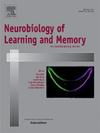Investigations of forgetting in Caenorhabditis elegans
IF 1.8
4区 心理学
Q3 BEHAVIORAL SCIENCES
引用次数: 0
Abstract
The traditional view considered forgetting as a passive process where memory traces gradually fade due to the natural weakening of neural connections. However, studies on olfactory memory in Drosophila have revealed that forgetting is an active process controlled by specific neural circuits. Caenorhabditis elegans is a widely used model organism in neurobiological research due to its relatively simple nervous system. Despite its simplicity, C. elegans exhibits complex behaviors influenced by environmental factors and prior experiences. Similar to Drosophila, C. elegans can actively initiate neural circuits based on the type of memory that needs to be forgotten, which supports using C. elegans as a model for studying forgetting. These characteristics facilitate the identification of genes and pathways involved in forgetting in C. elegans. In this review, we discuss recent advances in understanding forgetting mechanisms in C. elegans through three well-characterized olfactory learning paradigms. The insights derived from C. elegans offer a valuable framework for understanding the molecular and cellular mechanisms underlying forgetting, with potentially broader implications for memory regulation in more complex organisms.
秀丽隐杆线虫遗忘的研究
传统的观点认为,遗忘是一个被动的过程,由于神经连接的自然减弱,记忆痕迹逐渐消失。然而,对果蝇嗅觉记忆的研究表明,遗忘是一个由特定神经回路控制的活跃过程。秀丽隐杆线虫因其相对简单的神经系统而成为神经生物学研究中广泛使用的模式生物。秀丽隐杆线虫虽然简单,但却表现出受环境因素和先前经验影响的复杂行为。与果蝇类似,秀丽隐杆线虫可以主动启动基于需要遗忘的记忆类型的神经回路,这支持将秀丽隐杆线虫作为研究遗忘的模型。这些特征有助于识别秀丽隐杆线虫遗忘过程中涉及的基因和途径。在这篇综述中,我们通过三种特征良好的嗅觉学习范式讨论了秀丽隐杆线虫遗忘机制的最新进展。来自秀丽隐杆线虫的见解为理解遗忘背后的分子和细胞机制提供了一个有价值的框架,对更复杂生物体的记忆调节具有潜在的更广泛的意义。
本文章由计算机程序翻译,如有差异,请以英文原文为准。
求助全文
约1分钟内获得全文
求助全文
来源期刊
CiteScore
5.10
自引率
7.40%
发文量
77
审稿时长
12.6 weeks
期刊介绍:
Neurobiology of Learning and Memory publishes articles examining the neurobiological mechanisms underlying learning and memory at all levels of analysis ranging from molecular biology to synaptic and neural plasticity and behavior. We are especially interested in manuscripts that examine the neural circuits and molecular mechanisms underlying learning, memory and plasticity in both experimental animals and human subjects.

 求助内容:
求助内容: 应助结果提醒方式:
应助结果提醒方式:


